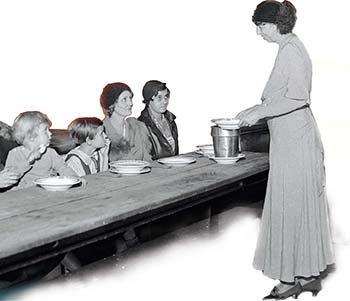SECTION 3: Effects of the New Deal

▲ Eleanor Roosevelt serves food to unemployed women and their children.
WITNESS HISTORY  AUDIO
AUDIO
The Caring First Lady
Eleanor Roosevelt played a crucial role in the New Deal. She traveled to places FDR could not, advised her husband, and served as an inspiration to millions of Americans. Mrs. Roosevelt also corresponded with thousands of citizens. The following letter reflects the affection that many citizens felt for the first lady.
“Ridley Park, Pennsylvania
Dear Mrs. Roosevelt:
… Just to look at your picture and that of our President seems to me like looking at the picture of a saint. So when you answered my letter and promised to have some one help me it only proved that you are our own Mrs. Roosevelt. I have told everyone what you have done for me. I want them to know you are not too busy to answer our letters and give us what help and advice you can. You hold the highest place any woman can hold still you are not to[o] proud to befriend the poor…. Thank you and God bless you both.”
—Letter to Eleanor Roosevelt, September 1, 1935
Objectives
- Describe how the New Deal affected different groups in American society.
- Analyze how the New Deal changed the shape of American party politics.
- Discuss the impact of Franklin D. Roosevelt on the presidency.
Terms and People
- Black Cabinet
- Mary McLeod Bethune
- Indian New Deal
- New Deal coalition
- welfare state
NoteTaking
Reading Skill: Identify Main Ideas As you read, identify the lasting effects of the New Deal upon American society.

Why It Matters The New Deal provided desperately needed relief from the depression and enacted reforms that guarded against economic catastrophe. It did not end the depression. World War II, with its massive military spending, would do that. Yet, the New Deal mattered enormously because it brought fundamental changes to the nation. It changed the role of the federal government in the economy, the power of the presidency, and the relationship of the American people to their government. Section Focus Question: How did the New Deal change the social, economic, and political landscape of the United States for future generations?
Women Help Lead the New Deal
The New Deal provided some women with the opportunity to increase their political influence and to promote women’s rights. Foremost among them was Eleanor Roosevelt, who transformed the office of First Lady from a largely ceremonial role to a position of action and deep involvement in the political process. Representing the President, she toured the nation. She visited farms and Indian reservations and traveled deep into a coal mine. She helped FDR on his campaigns and offered advice on policy issues. In her newspaper column, “My Day,” she called on Americans to live up to the goal of equal justice for all.




